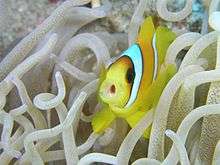Macrodactyla doreensis
| Macrodactyla doreensis | |
|---|---|
.jpg) | |
| Scientific classification | |
| Kingdom: | Animalia |
| Phylum: | Cnidaria |
| Class: | Anthozoa |
| Subclass: | Hexacorallia |
| Order: | Actiniaria |
| Family: | Actiniidae |
| Genus: | Macrodactyla |
| Species: | M. doreensis |
| Binomial name | |
| Macrodactyla doreensis (Quoy & Gaimard, 1833) | |
| Synonyms | |
|
Macrodactyla gelam (Mariscal 1972) | |
Macrodactyla doreensis, common names long tentacle anemone and corkscrew tentacle sea anemone,[1] is a species of sea anemone in the family Actiniidae.
Description
Macrodactyla doreensis has relatively few tentacles. They are all similar to one another in size and colour, being purplish-gray to brown. Each grows to about 1.75 cm, are sinuous, and each taper evenly toward the tip. In some cases they have a corkscrew shape.
The oral disc is normally purplish-gray to brown, and sometimes has a green cast. It has a flared shape, and grows to a maximum of 5 cm wide, but is often far smaller. It has white lines that are oriented radially, sometimes extending onto the tentacles.
This anemone remains at the surface of the sediment, with the column buried. The lower portion of the column is a dull orange to bright red colour, with the upper portion being brownish, containing a round to ovoid verrucae in rows oriented longitudinally.
Distribution
This species is found in Japan, and south to the waters of New Guinea and northern Australia.[1]
Behaviour
The tentacles of Macrodactyla doreensis may either shrivel, or stick to hand of a person who disturbs it. This anemone can retract entirely into the sediment.[1]
Habitat
This species is commonly found at depths of 5 metres or less in muddy bottoms, and is commonly seen without fish present.
Symbionts

M doreensis is a host of 5 different species of fish.[1][n 1]
- Amphiprion chrysopterus orange-fin anemonefish [2]
- A. clarkii, the yellowtail anemonefish
- A. ocellaris Western clownfish
- A. perideraion pink skunk anemonefish.
- Dascyllus trimaculatus 3 spot dascyllus.
Notes
- ↑ M. doreensis was recorded [1] as a host of Amphiprion chrysogaster, the Mauritian anemonefish, however this was an error.[2]
References
- 1 2 3 4 5 Fautin, Daphne G.; Allen, Gerald R. (1997). Field Guide to Anemone Fishes and Their Host Sea Anemones. Western Australian Museum. ISBN 9780730983651. Archived from the original on 14 April 2015.
- 1 2 Ollerton J; McCollin D; Fautin DG; Allen GR. (2007). "Finding NEMO: nestedness engendered by mutualistic organization in anemonefish and their hosts". Proc R Soc B Biol Sci. (274): 591–598. doi:10.1098/rspb.2006.3758.
External links
| Wikimedia Commons has media related to Macrodactyla doreensis. |
| Wikispecies has information related to: Macrodactyla doreensis |
- "Macrodactyla doreensis". Integrated Taxonomic Information System.
- * Macrodactyla doreensis. Quoy & Gaimard, 1833. Retrieved through: World Register of Marine Species.
- Fautin, D. "Macrodactyla doreensis". Hexacorallians of the World.